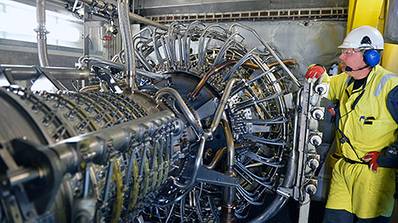Statoil: New Compressor Means Heightened Production

The compressor will help boost recovery rate and accelerate production on the Kvitebjørn field. (Photos: Harald Pettersen)
The new compressor in operation on the Kvitebjørn field in the North Sea from 17 September will increase production there by 220 million barrels of oil equivalent and extend the field’s lifetime with eight years.
The compressor will help boost recovery rate and accelerate production on the Kvitebjørn field. (Photos: Harald Pettersen)
The new compressor contributes to an increase in the recovery rate at the Kvitebjørn field from 55% to 70%. “These are very profitable barrels, which make a considerable contribution to wealth creation on the Norwegian continental shelf.
Increased production and extended lifetime for the field also provides increased ripple effects across the entire value chain,” says Kjetil Hove, senior vice president for operations in Development and Production Norway in Statoil.
Valuable modules
The compressor project is making a substantial contribution to the increased recovery of gas resources from the field, which has increased its reserves by 50% since the plan for development and operation was submitted in 2000.
The extra barrels from the compressor are equivalent to a medium-sized, separately developed field.
“Many people don’t realise that these relatively small modules are able to contribute as much or more value as new fields and that they cost much less to develop because the platform is already in place,” explains Statoil brownfield projects senior vice president Terese Kvinge.
The reason why the new compressor is being installed on a field that has been in production for some years is that pressure in the reservoir has gradually fallen as the oil and gas has been produced. By lowering the pressure on the platform, more can be produced.
Bilde
Click on the illustration above to see more photos from Kvitebjørn on our Flickr account.
The compressor module was built by Bergen Group Rosenberg (now Rosenberg Worley Parson Group) in Stavanger. The 1000-tonne module was lifted into position during the summer of 2013.
This is the first phase of pre-compression on Kvitebjørn, but space has been left in the new module for a potential second pre-compression phase as well.
Kvitebjørn value chain
Rich gas and condensate (light oil) from Kvitebjørn are piped to Kollsnes near Bergen and Mongstad further north respectively.
After processing at Kollsnes, the dry gas is piped to continental Europe. The separated NGL is transported by pipeline to the Vestprosess plant at Mongstad for fractionation into propane, butanes and naphtha.
Condensate travels through the Kvitebjørn Oil Pipeline, which ties into the Troll Oil Pipeline II to Mongstad.







